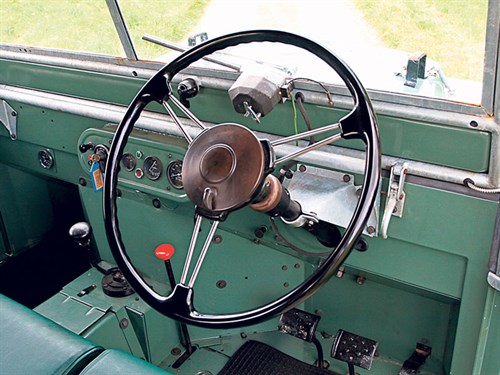
The S1 was a light utility with four-wheel-drive to deliver rough-terrain ability that no other light commercial had. The base model was a pick-up, usually with a canvas tilt in the UK. Tickford’s coachbuilt Station Wagon was too expensive to last beyond 1951, but a "Meccano-set" wagon appeared in 1953. The original model had an 80-inch wheelbase, while from 1953, an 86-inch wheelbase gave more space. From 1956 88 inches made room for the optional diesel engine.
VITAL STATISTICS
LAND-ROVER SERIES I 86-INCH
Engine 1997cc/4-cyl/overhead inlet
Power (bhp@rpm) 52bhp@4000rpm
Torque (lb ft@rpm) 101 lb ft @1500rpm
Top speed 60mph
0-60mph 25sec
Consumption 23mpg
Gearbox 4-speed manual
WHAT TO LOOK FOR
BODYWORK & CHASSIS
The panels are Birmabright aluminium alloy with galvanised steel cappings to stiffen and hold them together; the bulkhead and door frames are also steel. The alloy corrodes where it touches steel, but can also be gashed from hard use. Don’t worry if the paint has worn off; the panels won’t rust.
However, the bulkhead is critical to the whole structure, so you should always make sure that it is sound. Check particularly in the footwells and at the exposed ends, which form the door pillars. Re-manufactured bulkheads can be bought, but a re-build is a big job.
Some 86 and 88 Station Wagons were created from pick-up models by adding the relevant body parts. It takes an expert to spot the fakes. Tickford Station Wagons have a unique timber-framed body and are very expensive to restore. Some body parts for the 107 Station Wagons can be hard to find.
ENGINE
Petrol engines all have the same basic design, with overhead inlet and side exhaust valves. The 1948-1951 80-inch has a 1595cc type, and all later Series Is have a 1997cc type. Up to mid-1954, these have siamesed bores; later ones have water between all the bores. The diesels were only in 88-inch and 109-inch chassis, and are 2052cc OHV types. Of course, lots of other engines can be persuaded to fit, and have been!
The diesels were always slow and noisy, and are rare in good condition today. The petrol engines enjoy good parts support, although you may have to settle for some non-original items. An engine in good condition purrs gently and pulls well, although good road performance was never on the agenda. Tappets need regular adjustment, and oil leaks are more or less standard. Expect a smell of petrol: you’re sitting on the tank!

RUNNING GEAR
The chassis was not galvanised as standard, despite persistent rumours to the contrary. It’s a strong box-section design, and the outriggers that carry the body rust first. Check the top surfaces of the side members, where rust can go unnoticed. Look carefully at the back end, too, especially the rear cross-member.
Land-Rovers can obviously be subjected to rougher than usual use, so check for chassis damage. The cross-member under the gearbox might have been rammed hard up against the gearbox casing. The all-round leaf springs can sag and break from neglect. They are handed and there are several types; a lopsided look suggests the wrong ones have been fitted. Spring bushes and shackles are further consumable items.
Axles may be noisy, but can go on for a long time if they are oil-tight. Half-shafts break, and are difficult to find. The gearbox has no synchromesh between first and second; watch for it jumping out of mesh on the over-run. Expect clunks and bangs in the driveline because there are a lot of joints in it. The front hub swivels should have a smooth, chromed finish; pitting causes oil leaks and wear.
INTERIOR
Don’t expect sophistication. Bodies will not be water-tight or exclude draughts; that’s all part of their charm.
There are three front seats, unless the centre one has been removed for access to a centre power take-off. Station Wagons have inward-facing seats in the rear, and 107 wagons an additional centre row. The upholstery is vinyl and will likely be green (or, less commonly, grey or blue).

OUR VERDICT
You get character with a Land-Rover – bags of it. They are great fun to drive (but not for long distances), will go where ordinary cars simply won’t go, and are strangely addictive. A Series I Land-Rover is not like any other classic car you’ll buy, and you really will get to love its faults. It can actually be useful, too.